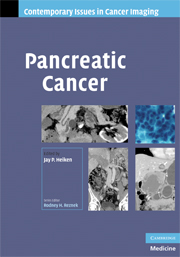Book contents
- Frontmatter
- Contents
- Series Foreword
- Preface to Pancreatic Cancer
- Contributors
- 1 Epidemiology and genetics of pancreatic cancer
- 2 Pathology of pancreatic neoplasms
- 3 Multi-detector row computed tomography (MDCT) techniques for imaging pancreatic neoplasms
- 4 Magnetic resonance imaging (MRI) techniques for evaluating pancreatic neoplasms
- 5 Imaging evaluation of pancreatic ductal adenocarcinoma
- 6 Imaging evaluation of cystic pancreatic neoplasms
- 7 Imaging evaluation of pancreatic neuroendocrine neoplasms
- 8 Role of endoscopic ultrasound in diagnosis and staging of pancreatic neoplasms
- 9 Surgical staging and management of pancreatic adenocarcinoma
- 10 Treatment of locally advanced and metastatic pancreatic cancer
- 11 Rare pancreatic neoplasms and mimics of pancreatic cancer
- Index
- Plate section
- References
3 - Multi-detector row computed tomography (MDCT) techniques for imaging pancreatic neoplasms
Published online by Cambridge University Press: 23 December 2009
- Frontmatter
- Contents
- Series Foreword
- Preface to Pancreatic Cancer
- Contributors
- 1 Epidemiology and genetics of pancreatic cancer
- 2 Pathology of pancreatic neoplasms
- 3 Multi-detector row computed tomography (MDCT) techniques for imaging pancreatic neoplasms
- 4 Magnetic resonance imaging (MRI) techniques for evaluating pancreatic neoplasms
- 5 Imaging evaluation of pancreatic ductal adenocarcinoma
- 6 Imaging evaluation of cystic pancreatic neoplasms
- 7 Imaging evaluation of pancreatic neuroendocrine neoplasms
- 8 Role of endoscopic ultrasound in diagnosis and staging of pancreatic neoplasms
- 9 Surgical staging and management of pancreatic adenocarcinoma
- 10 Treatment of locally advanced and metastatic pancreatic cancer
- 11 Rare pancreatic neoplasms and mimics of pancreatic cancer
- Index
- Plate section
- References
Summary
Introduction
From the earliest clinical experiences with single slice computed tomography (CT) to today's multi-detector row CT (MDCT) era, it has been apparent that successful imaging detection of pancreatic neoplasms is significantly improved by the use of pancreas-specific examination protocols [1]. The primary goal in imaging patients suspected of a pancreatic neoplasm is to confidently detect or exclude its presence. If a pancreatic neoplasm is found, the imaging study should provide an accurate assessment of the parameters that will allow appropriate treatment selection for each patient. This chapter examines in detail the specific elements that comprise an MDCT pancreatic protocol. Radiologists reading this chapter will be able to adapt these recommended imaging parameters to their own site. Non-radiologist clinicians will gain a sense of the strengths and limitations of properly performed MDCT scanning for pancreatic disease and will be encouraged to make the radiologist aware of the clinical suspicion such that the patient can be examined with the best possible technique.
The pancreatic protocol used at our institution will be reviewed with emphasis on how each element of the protocol improves imaging accuracy. Although the primary focus will be on the evaluation of pancreatic ductal adenocarcinoma, we will also explore specific utility for neuroendocrine tumors and cystic pancreatic neoplasms.
MDCT pancreatic protocol components
A well-designed imaging protocol must specify the types of patients for whom the protocol is appropriate, provide the technologist with appropriate acquisition parameters, and take into consideration the radiation dose delivered to the patient.
- Type
- Chapter
- Information
- Pancreatic Cancer , pp. 28 - 45Publisher: Cambridge University PressPrint publication year: 2008



